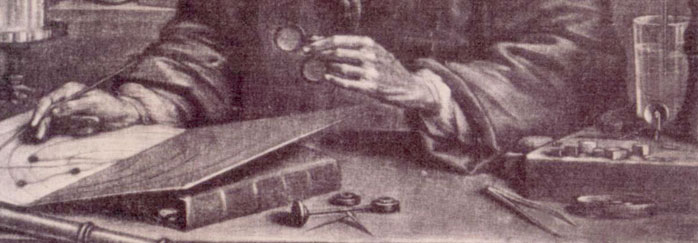Petrus van Musschenbroek (1692 - 1761)
 Field(s) of interest: physics | mathematics | medicine | meteorology
Field(s) of interest: physics | mathematics | medicine | meteorologyGender: male
Born: Leiden, 14-03-1692
Died: Leiden, 19-09-1761
Biography:
Petrus van Musschenbroek belonged to a family of brass founders and instrument makers who had turned to the construction scientific instruments in the middle of the seventeenth century. His father Johan, his uncle Samuel, and his brother Jan all earned solid reputations in this field, Jan working closely with the Leiden natural philosopher Willem Jacob 's Gravesande. Petrus, five years younger than Jan, studied at the University of Leiden and in 1715 earned his doctorate in medicine. After a visit to England (where he met Desaguliers) he practiced medicine in Leiden for a few years, but after receiving a second degree in philosophy he accepted a professorate in mathematics and philosophy in Duisburg in 1719. In 1721 he also became extraordinary professor of medicine. In 1723 Musschenbroek moved to Utrecht, where he held the position of professor of natural philosophy and mathematics. The following year he married Adrina van de Water (who died prematurely in 1732). From 1732 onwards, Musschenbroek also was professor of astronomy in Utrecht. Here he became well known for his lectures in experimental philosophy, in which he followed the new guidelines set forth by Newton and 's Gravesande. His textbooks became famous far outside the lecture halls of Utrecht. In 1726 he published Epitome elementorum Physico mathematicorum conscripta in usus academicos, followed by Elementa physicae in 1734. Musschenbroek refused offers from Copenhagen (1731) and Göttingen (1737), but he accepted a call from Leiden in 1739, where he lectured on philosophy from 1740 until his death. In 1742 he succeeded the deceased 's Gravesande as professor of experimental natural philosophy. His lectures, which attracted many foreign students, were published as his Institutiones physicae (1748) and his Introductio ad philosophiam naturalem (posthumously published in 1762 by Lulofs). During his lectures Musschenbroek used instruments that more often than not were devised by himself and constructed by his brother Jan (except for the barometers and thermometers, which were made by Fahrenheit and others). Compared to 's Gravesande, Musschenbroek paid more attention to the experimental gathering of facts and less to the mathematical formulae to which these facts had to be reduced. Accordingly, Musschenbroek's research was concerned with other topics than 's Gravesande had considered important. Whereas 's Gravesande extensively discussed mechanics and astronomy, Musschenbroek gave much attention to, for instance, the effects of heating and to meteorology and electricity. He constructed the pyrometer and is credited with the invention of the Leiden jar (1746). Because of his experimental approach, one of his biographers characterized Musschenbroek as a Newtonian scientist with a Baconian bent.
Collection: Museum Boerhaave Leiden.
Occupations:
doctor: 1716 - 1719 (Leiden)
professor: 1719 - 1723 (Duisburg)
professor: 1723 - 1740 (Utrecht)
professor of mathematics and philosophy: 1740 - 1761 (Leiden)
instrument maker
Sources:
Musschenbroek, P. van, Institutiones physicæ conscriptæ in usus academicos (Leiden 1748).
Leiden, UB : BPL 240; Letter by Dirk Metz (1731 fl.) to Petrus van Musschenbroek (1692-1761).
Musschenbroek, P. van, Disputatio medica inauguralis de aëris praesentia in humoribus animalibus ... ex auctoritata ... Wolferdi Senguerdii ... (Leiden 1715).
Musschenbroek, P. van, Introductio ad philosophiam naturalem (Leiden 1762).
Musschenbroek, P. van, Essai de physique (Leiden 1739).
Musschenbroek, P. van, Epitome elementorum physico-mathematicorum (Leiden 1726).
Rooseboom, M., Bijdrage tot de geschiedenis der instrumentmakerskunst in de noordelijke Nederlanden (Leiden 1950).
Clercq, P. de, At the sign of the oriental lamp. The Musschenbroek workshop in Leiden, 1660-1750 (Rotterdam 1997).
Mörzer Bruyns, W.F.J., Schip recht door zee : de octant in de Republiek in de achttiende eeuw (Amsterdam 2003).
Fournier, M., Early microscopes : a descriptive catalogue (Leiden 2003).
Crommelin, C.A., 'Leidsche leden van het geslacht Van Musschenbroek', Jaarboekje voor geschiedenis en oudheidkunde van Leiden en omstreken (1939).
Musschenbroek, P. van, Beginselen der natuurkunde, beschreven ten dienste der landgenooten (Leiden 1736); second enlarged edition: 1739
Pater, C. de, Petrus van Musschenbroek (1692-1761): een newtoniaans natuuronderzoeker (Utrecht 1979)

